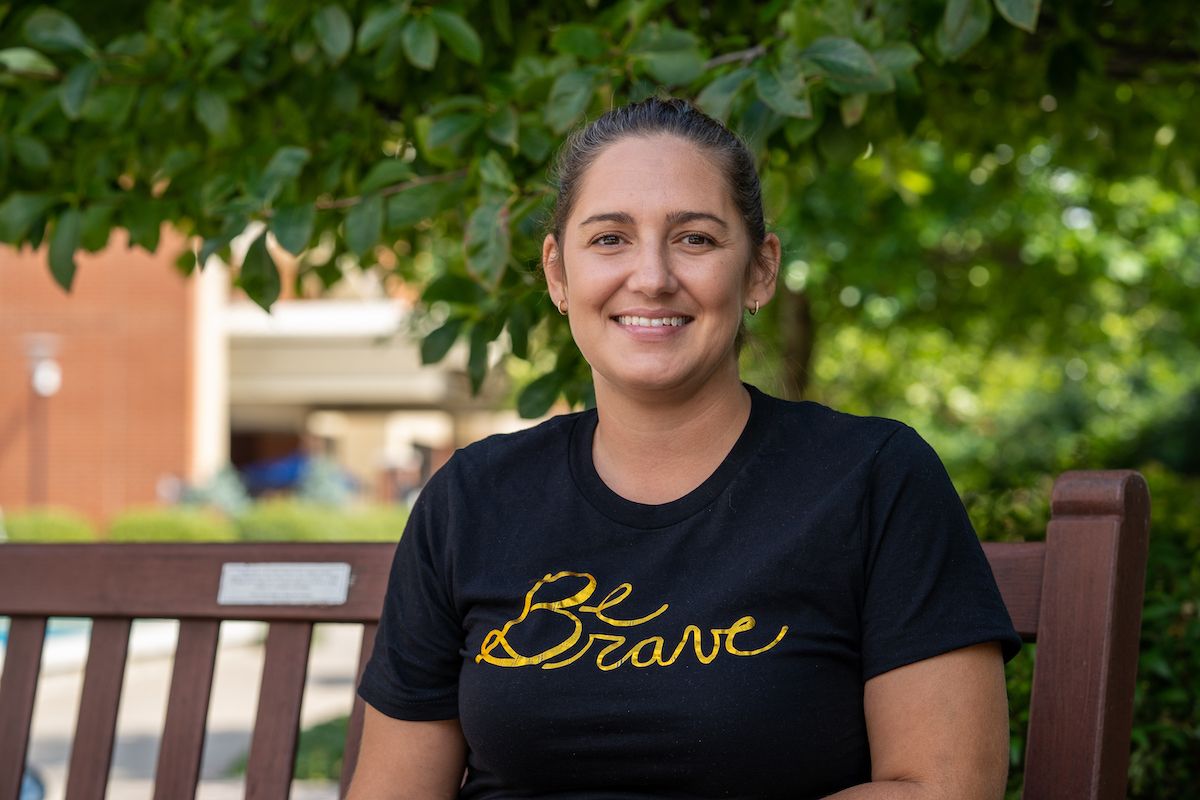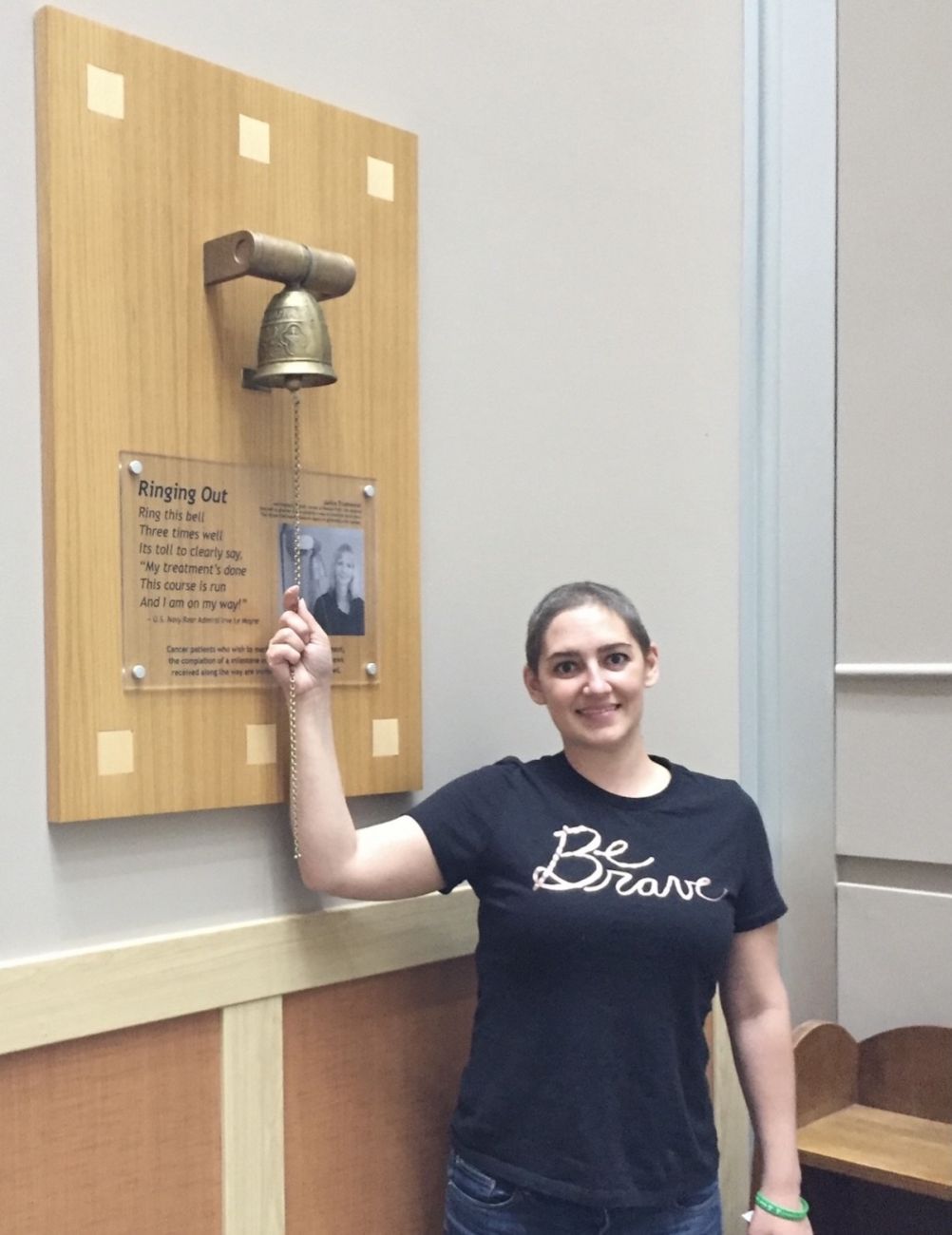How creating t-shirts with her “Be Brave” mantra and using virtual reality technology helped her cope during cancer treatment
Heather Bucalos, a two-time lymphoma survivor, has a message for her fellow cancer patients: “Be brave.” Easier said than done, right? “Correct,” Heather says. But as a registered nurse, a former certified educator in LaMaze childbirth breathing techniques, infant massage and healing touch modalities, and most personally, as a stem-cell transplant patient, Heather is a true believer in the effects of mindfulness and relaxation techniques. “Our brains are powerful tools that can be trained to help calm our minds and heal our bodies,” she says.
And when Heather’s Hodgkin lymphoma relapsed at the end of 2019, she knew she would need a lot of calming and healing.
“My treatment called for an autologous stem cell transplant that entailed intensive chemotherapy, radiation and a month-long stay at Roswell Park, where I would be confined to my hospital room. I knew that the treatment might leave me infertile and would catapult me into medically induced menopause. And, while the U.S. wasn’t yet fully affected, the COVID-19 pandemic was rapidly spreading around the world, and I would be severely immunocompromised as part of my treatment and recovery. This was by far the most frightening and difficult regimen I'd had since my first rendezvous with lymphoma treatment in 2014. I didn't want to do this, but I knew I had to,” Heather says.
A reminder to “Be Brave”
“My friend Cassandra has a T-shirt design business. I asked her to make me a T-shirt that said, ‘Be Brave.’ Cassandra had me write those words, and then incorporated my own handwriting into a design that was printed on the shirt. I wore the shirt to all of my appointments at Roswell Park before and during my transplant. Every time I wore the shirt and looked in the mirror, I whispered to myself, ‘Be brave.’ That little message was the most important reminder through my toughest days, and there were many. But with every reminder I felt stronger and more prepared for whatever was to come,” Heather says.
After her month-long stay in the transplant unit, Heather wore her Be Brave shirt as she rang the Victory Bell. She continues to wear the shirt to each follow-up appointment and scan at Roswell Park Comprehensive Cancer Center. “Even though the most difficult part of my treatment is over, there is always someone who might see the message on my shirt and could use a little reminder to be brave, because you're stronger than you know,” says Heather.
And for those who want to encourage themselves or inspire others with this message of courage, Heather’s ‘Be Brave’ T-shirts are now available for sale at the Roswell Park gift shop. A portion of all the proceeds from the T-shirt sales is donated to the Roswell Park Alliance Foundation.
Looking for relief from side effects
This T-shirt is not the only way Heather is working to help herself and other cancer patients overcome pain and fear. “During my initial treatment, I suffered from just about every chemotherapy side effect, including migraines, spleen pain, nausea and stomach ulcers,” Heather says. “The pain was so severe that almost every other week, between my chemotherapy sessions, I needed to go to the ER for an infusion of morphine.” Long a proponent of mindfulness and integrative medicine, Heather began working with a psychologist who created a customized meditation recording to help “calm me and direct my attention away from my pain and anxiety during treatment,” Heather says.
In the following years, Heather also began exploring virtual reality (VR) as another way for patients to escape from pain and stress. “One of my friends had a Google Cardboard device, which was an early version of virtual reality goggles. I knew that doctors at Roswell Park had used virtual reality to simulate the operating room experience while training physicians to do robotic surgeries. And I thought, ‘Why couldn’t we use virtual reality to help patients simulate being someplace that brings them joy or helps relieves their stress and pain?’ We know that stress is detrimental to the immune system. What we need in the hospital, or other stressful long-term situations, is to create a healing environment in as many ways as possible.”
Virtual reality provided an escape
Heather was onto something. Many studies, including some by Roswell Park researchers, have confirmed that relieving stress can help patients heal faster and better. Heather had already started networking with virtual reality companies and healthcare facilities to promote her idea when she suffered her relapse. She offered to be the “guinea pig” to test using VR while she underwent treatment.
“A person experiences an identity shift when they become a patient in a hospital. There is a loss of autonomy, freedoms, social norms and privacy. We are no longer in control of our own physical world around us. We have entered another world, the medical world,” Heather says. “As a transplant patient, those feelings are compounded with a sense of isolation. Because patients in the transplant unit are so immune-compromised due to high doses of chemotherapy, we are isolated from the rest of the hospital. The two sets of double doors going into the unit provide each patient one grand entrance at admission and one grand exit upon discharge. There is no coming and going, no visits to the cafeteria or healing garden. The only escape is a possible wheelchair excursion for CT scan. No amount of tropical room décor could hide the full reality of being where I was, or the fact that I wasn't allowed to leave the unit for almost a month.
“So, I used VR to escape,” Heather says. “Virtual reality allowed me to curate a new personal environment. Since VR headsets block out the user’s peripheral vision, the brain is able to fully concentrate on only what it perceives is in front of the eyes. There is a big difference between watching a movie on an iPad in a hospital bed and watching the same movie using a VR headset in a hospital bed. The VR headset allows you to block out visual and audible reminders that you are surrounded by the medical world.”
Heather’s virtual journeys included trips to a quiet lodge in Colorado, surrounded by snow-capped mountains and a crackling fireplace, and a walk through the hiding place where Anne Frank wrote her famous diary. “The first virtual trip helped to relax me; the virtual visit to the Anne Frank House museum helped give me perspective that even in the hospital and even during lockdown during a pandemic, I still had more freedom than many others have had throughout history,” Heather says.
Heather’s experience of using VR during her stay at Roswell Park was included in a cover story in the Spring 2020 issue of Cure, a publication about cancer updates, research and education. In September 2021, Heather also was a featured virtual speaker at Europe’s largest conference and expo for virtual reality, augmented reality and mixed reality in healthcare.
Now more than a year after her transplant, Heather continues to don her VR goggles to help relieve anxiety before scans and other procedures.
Although there may seem to be a big difference between the low tech of a T-shirt bearing a positive message and the high tech of a virtual escape from the realities of being a patient, Heather notes that there is one main similarity. “What we focus on becomes our own personal reality,” she says. “So, by all means, focus on ways to help yourself escape, heal and be brave as you go through your treatment.
Never miss another Cancer Talk blog!
Sign up to receive our monthly Cancer Talk e-newsletter.
Sign up!Editor’s Note: Cancer patient outcomes and experiences may vary, even for those with the same type of cancer. An individual patient’s story should not be used as a prediction of how another patient will respond to treatment. Roswell Park is transparent about the survival rates of our patients as compared to national standards, and provides this information, when available, within the cancer type sections of this website.





